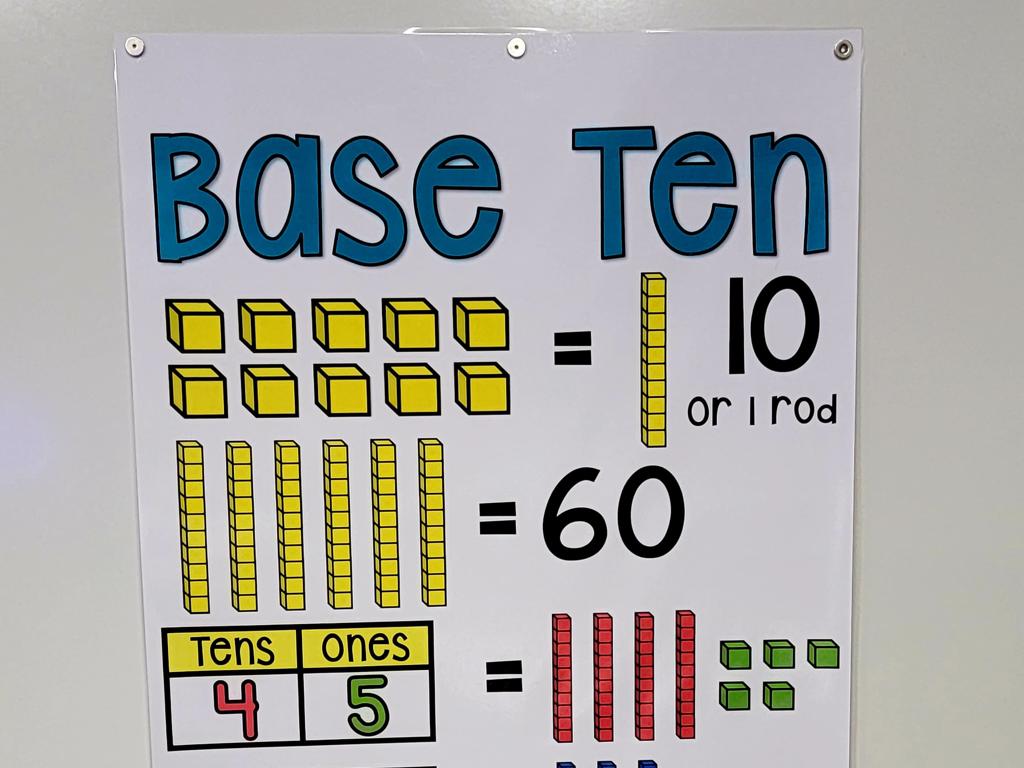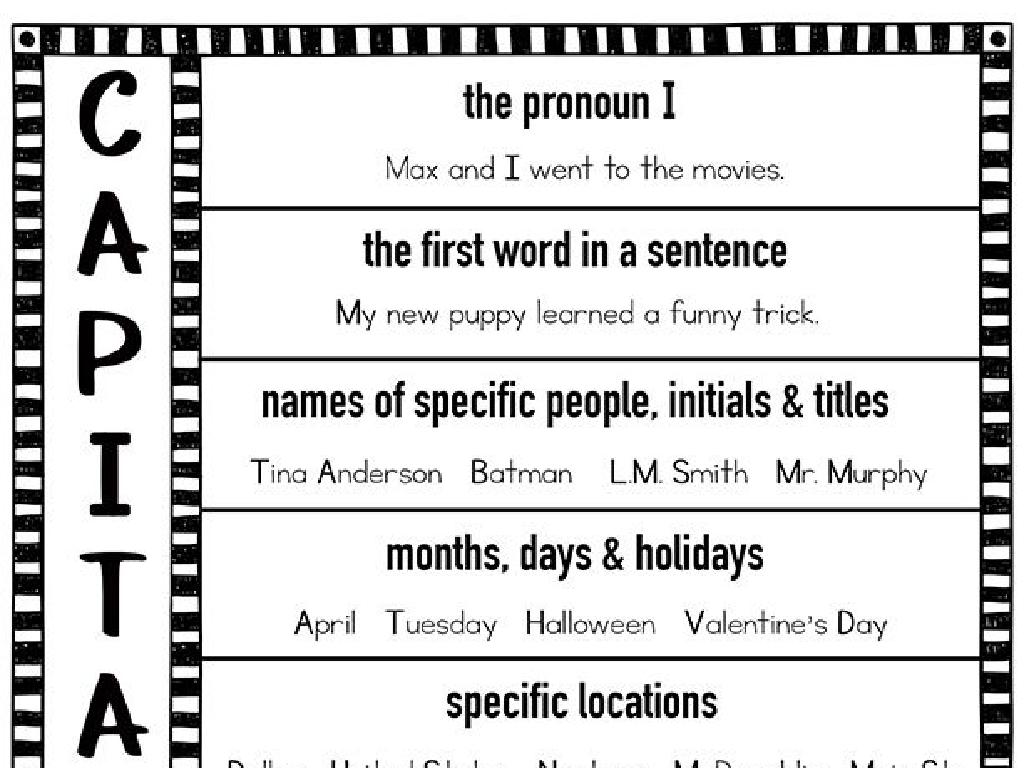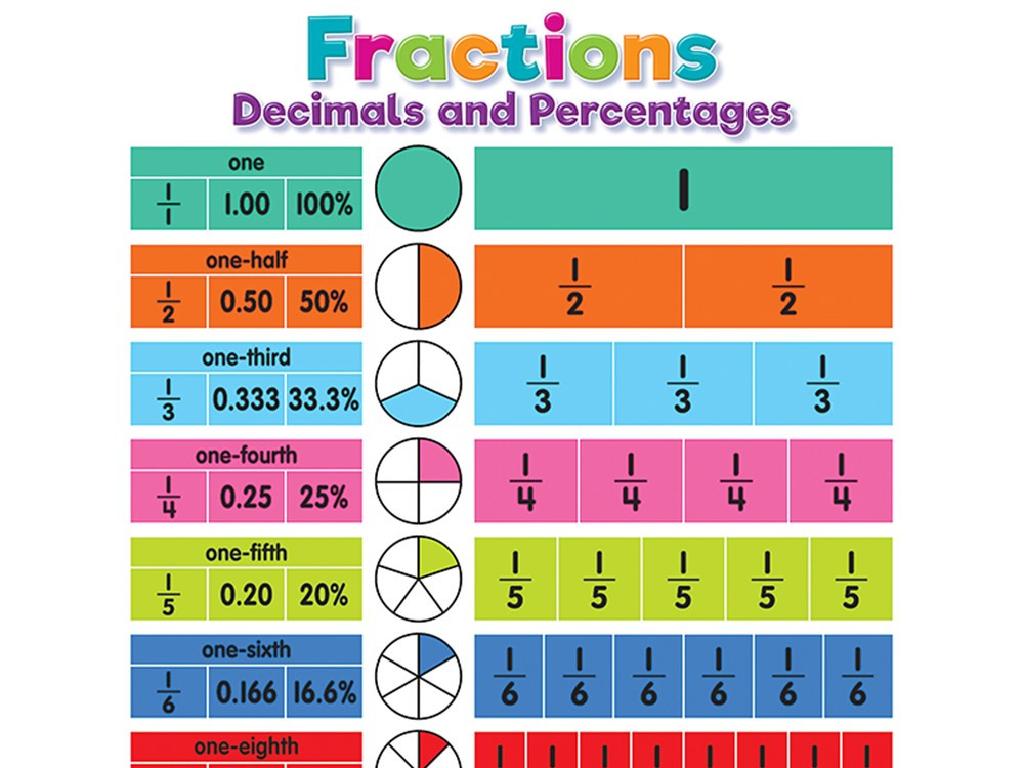Addition Sentences Using Number Lines - Sums To 20
Subject: Math
Grade: Second grade
Topic: Addition Strategies: One Digit
Please LOG IN to download the presentation. Access is available to registered users only.
View More Content
Welcome to Addition!
– Learn about addition sentences
– Using number lines for addition
– A number line helps us count the steps between numbers
– Add numbers up to 20
– We’ll practice adding numbers from 1 to 20
– Become an addition expert
– With practice, you’ll be able to add quickly and accurately
|
This slide introduces the concept of addition sentences and how to use number lines to add numbers up to 20. Start by explaining what an addition sentence is: a math problem that shows two or more numbers being added together. Demonstrate how to use a number line by starting at the first number in the addition sentence and ‘hopping’ the number of steps equal to the second number. Encourage the students to participate by having them come up to the board to solve addition problems using a number line. Provide plenty of examples and practice opportunities to ensure that students are comfortable with the concept. By the end of the lesson, students should feel confident in their ability to use number lines to add numbers up to 20.
Understanding Addition Sentences
– What is an addition sentence?
– It’s like a math sentence showing numbers combined with a plus sign.
– Example: 4 + 3 = 7
– See how 4 and 3 come together to make 7?
– ‘Sum’ refers to the answer
– The sum is the total you get after adding.
– Using number lines for sums to 20
– A number line helps us add step by step up to 20.
|
This slide introduces the concept of addition sentences to second-grade students. Start by explaining that an addition sentence is a way to write down the action of combining two or more numbers. Use simple examples like 4 + 3 = 7 to illustrate this point. Clarify that the result of this addition, called the sum, is the total amount you have after adding the numbers together. Introduce the number line as a visual tool that can help students understand and solve addition problems by taking one step for each number added, ensuring they grasp the concept of sums up to 20. Encourage students to practice creating their own addition sentences and finding sums using number lines.
Using Number Lines for Addition
– What is a number line?
– A line with numbers at equal spaces
– Adding with jumps on a number line
– Start at the first number, jump forward by the second number
– Practice making jumps to add
– Let’s try adding 5 + 3 by making jumps
– Find sums up to 20
– Use the number line to add numbers quickly and find the total
|
This slide introduces second-grade students to the concept of using number lines for addition. Begin by explaining what a number line is and how it is organized. Demonstrate how to use a number line to add by starting at the first number and ‘jumping’ forward by the value of the second number. Engage the students with examples, such as adding 5 + 3, by making 3 jumps from 5 on the number line to reach 8. Encourage students to practice this technique with different numbers, ensuring they understand how to find sums up to 20. This visual and interactive method helps solidify their understanding of addition within 20.
Let’s Practice Together: Adding with Number Lines
– Start with the number 5
– Make 3 jumps to the right
– Each jump adds 1 more
– Find the sum where we land
– Starting at 5, we jump to 6, 7, and land on 8
|
This slide is an interactive class activity designed to help students understand the concept of addition using a number line. Begin by explaining that a number line is a visual tool that helps us count and add numbers. Demonstrate the process using the example provided: starting at number 5 on the number line, then making 3 consecutive jumps to the right, with each jump representing an addition of one. After the jumps, we land on the number 8, which is the sum of 5 + 3. Encourage students to visualize the jumps as they count and to understand that the position where they land represents the total amount. For the activity, provide each student with a number line and have them practice with different starting numbers and jumps, ensuring sums do not exceed 20. This hands-on experience reinforces their understanding of addition and number sequences.
Your Turn to Try: Adding on a Number Line
– Start with the number 6 on the line
– Make 2 jumps to the right
– Each jump adds 1 to the number
– Where did you land? That’s 6 + 2!
– Example: Starting at 6, two jumps lands you at 8
|
This slide is an interactive activity for students to practice adding single-digit numbers using a number line. Students should be familiar with the concept of a number line and how it can be used as a tool for addition. Encourage them to physically draw the number line and use their fingers or a marker to count the jumps. This exercise helps to reinforce the concept of addition as a series of increments. After completing the jumps, students should arrive at the number 8, demonstrating that 6 + 2 equals 8. Ask the students to share their results and ensure they understand the process. Prepare to assist any students who may have difficulty with the concept of counting on.
Adding Bigger Numbers Using Number Lines
– Start with larger first number
– Make jumps equal to second number
– Find the sum on the number line
– After 7 jumps from 10, we land on 17
– Practice with 12 + 5
– What number do we land on after 5 jumps from 12?
|
This slide introduces students to the concept of using number lines to add larger numbers, with sums up to 20. Begin by explaining that we start with the larger number on the number line, which is more efficient. Demonstrate making jumps on the number line equal to the value of the second number to find the sum. Use the example 10 + 7 to show how to count 7 jumps from 10. For the class activity, have students practice with the example 12 + 5 and find the sum by making 5 jumps from 12 on their own number lines. Encourage students to share their answers and explain the process they used to arrive at the sum. Provide guidance and ensure that each student understands the concept of adding by making jumps on the number line.
Class Activity: Number Line Hopscotch
– Let’s play Number Line Hopscotch!
– Draw a number line with chalk
– Make sure numbers 0-20 are marked
– Hop to add numbers up to 20
– Start at 0, hop the number of spaces to add
– Take turns and have fun!
|
This interactive activity helps students visualize addition by using a number line. Before starting, ensure that each student understands how to use a number line for addition. Draw a large number line on the classroom floor or playground, with numbers from 0 to 20. Students will take turns hopping on the number line to physically add numbers together. For example, to add 5 + 3, a student will stand on number 5 and then hop forward 3 spaces to land on 8. This kinesthetic approach reinforces the concept of addition as ‘moving forward’. Have a variety of addition problems ready for different skill levels, and encourage students to cheer each other on. This activity not only makes learning fun but also promotes physical activity and peer interaction.
Review: Addition with Number Lines
– What’s an addition sentence?
– It’s a math problem that adds numbers together, like 2 + 3 = 5.
– Using number lines to add
– Start at the first number, then hop forward by the second number’s value.
– Example: Adding 8 + 5
– Start at 8, make 5 hops forward to land on 13.
– Practice time!
|
Begin the review by asking students to recall what an addition sentence is, reinforcing the concept with examples. Then, transition to explaining how a number line can be used as a visual aid to add numbers together. Demonstrate this by using the example of 8 + 5, showing how to start at 8 on the number line and make 5 hops forward to reach the sum of 13. After the demonstration, engage the class by asking for volunteers to come up and show their own addition on the number line. Conclude with practice time, allowing students to work on their own or in pairs to create addition sentences and solve them using number lines. Provide guidance and ensure that each student is comfortable with the concept before moving on.
Homework Challenge: Number Line Additions
– Take home your number line worksheet
– Complete addition sentences up to 20
– Find pairs that add up to numbers <= 20
– Use your number line to find sums
– Example: For 8 + ?, draw a line from 0 to 8, then count up to the sum
– Bring completed worksheet to next class
|
This homework is designed to reinforce the concept of using number lines to solve addition problems with sums up to 20. Encourage students to carefully use the number line by starting at zero, counting on to the first number, and then adding the second number by counting on further. Remind them to mark each step on the number line for clarity. In the next class, review the completed worksheets to ensure understanding and celebrate their successful use of number lines. This activity will help solidify their addition skills and build confidence in using number lines as a visual aid.






